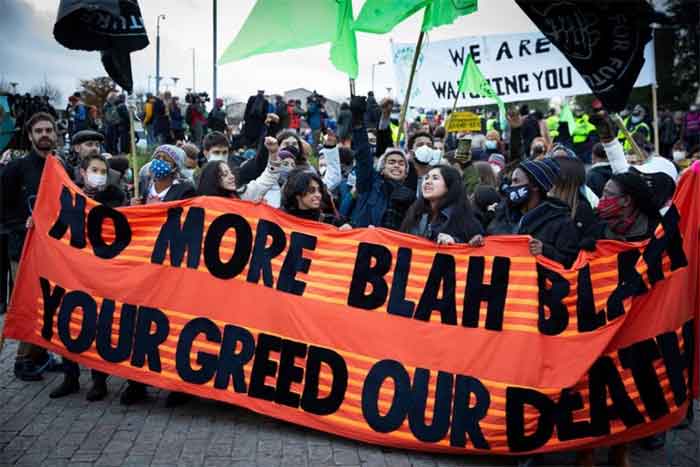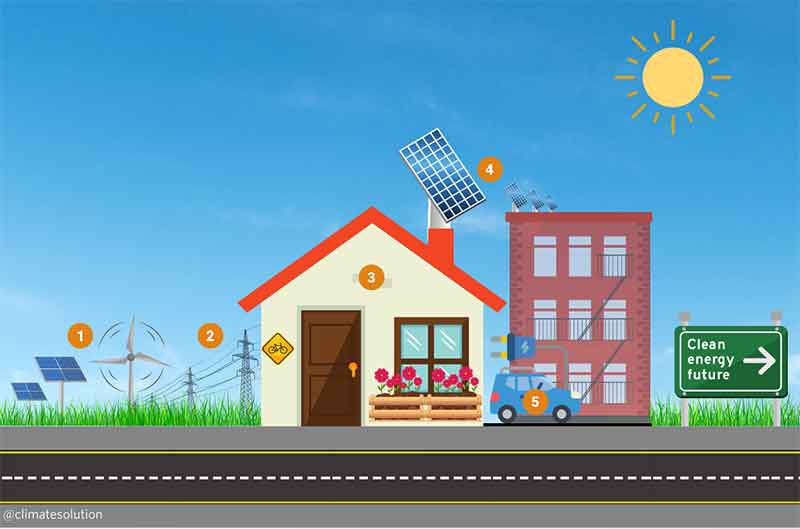
It’s apparent; Climate extremes are real. The last six years have been the hottest years on record. Megafires, polar melting, very severe cyclonic storms and other extreme weather events made half of the world population suffer. The Scientific community has warned the global leaders to take necessary steps to keep temperature rise below 1.5 degree Celsius. Countries have been forced to increase their national determined contributions (NDCs) to pacify the growing disappointment among the scientific community. Even the declared NDCs are fully implemented, nobody expects miracles. With the declared mitigation strategies, climate pledges and NDCs, we will move the pathway to 2.7 degrees. The latest updates from the NDC synthesis report shows that for all available NDCs of all 193 Parties taken together of about 13.7%, in global GHG emissions in 2030 compared to 2010 on average. We have to remember that the IPCC has estimated that limiting global average temperature increases to 1.5C requires a reduction of CO2 emissions of 45% in 2030 or a 25% reduction by 2030 to limit warming to 2C. If emissions are not reduced by 2030, they will need to be substantially reduced thereafter to compensate for the slow start on the path to net zero emissions.
Now the Political leaderships, religious figures, big corporate entities, NGOs and people’s movements, everyone talking about climate change and emission reductions. Net Zero is the latest buzzword of the climate action. Millions of climate refugees, especially from Sub-Saharan and South Asian countries and small Island states looking towards Glasgow with great expectations!
Some absence had been more visible than the presence in the blue zone in the COP-26. The biggest emitter of the present, China, whose GHG emission contributing 27% of the total, opted out from COP-26. The same way, two prominent petro-states, Russia and Saudi Arabia, has also decided to not participate in the Glasgow summit. Even though these three nations kept away themselves from the Climate summit, they had set their net zero target by 2060. India’s stand on emission reduction was unclear until the Prime Minister’s declaration in Glasgow.
Certainly, there are several questions arise on about the ongoing climate debate. Do the announced pledges and commitments guaranteed our chances of victory in the climate war we are about to fight? The financial and technological solutions which we put forward is sufficient enough to overcome the crisis? How serious our political leaderships, Business lobbies on their climate actions? How can we fight without having equity among the communities and assure the same for future generations?
All these questions are important for two reasons. First, the lack of perspectives and planning is evident in many of the projects announced at the official level. Second, it is our common delusion that we can find a solution within the existing system. Here I am trying to explain both of these issues.
Missing Perspectives
The Glasgow summit is being held somewhat in a festive atmosphere with plenty of pledges and commitments given by developed countries and emerging economies. Still there are missing links of perspectives and practicality. President Joe Biden has announced that US will cut funding for fossil fuel projects by 2022 and plans to launch a $ 2 trillion project to achieve the net zero goal by 2050. Without new climate legislation from Congress, Biden’s orders to reverse Trump’s rollbacks on emissions from vehicles, power plants and oil and gas drilling could be undone. But the reality is with a thin Senate majority limits the possibility for Biden to achieve climate legislation to curb carbon emissions. There are concerns over Germany’s commitment to phase out coal by 2038 as they have already on the path of closing nuclear power plants. 2050 net zero commitments have several convenient loopholes. No country has counted the emission for air travel and shipping in their national emission inventories.
Nonetheless China’s announcement of their net zero targets by 2060 and no more funding for overseas coal projects, as an emerging superpower, their GHG emission will increase for at least next two decades. A new analysis done by Carbon Brief shows, China’s carbon dioxide (CO2) emissions have grown at their fastest pace in more than a decade, increasing by 15% year-on-year in the first quarter of 2021.
It has been lauded that India’s commitments to achieve the net zero target by 2070 is based on pragmatism. Nevertheless, many questions arise related to India’s net zero goals. As Navroz Dubash, an eminent policy analyst from Centre for Policy Reserch, puts the straight questions, is India’s net zero target aims only CO2 or or all GHGs included? Is the 1 billion cumulative through 2030 or in 2030? Prime Minister also announced an ambitious 500GW non fossil fuel energy addition to India’s energy mix. But it is still unclear that whether this 50% increase RE means electricity generation or installed capacity? Dubash also raise the question whether the pledges made by India are conditional on receiving finance or unconditional? These questions are made valid not only because of the lack of a clear picture of declared commitments and pledges, but also the lack of institutional mechanisms in place to implement them.
Doubts are also being raised about the 500GW renewable energy plan announced by India’s Prime Minister in Glasgow. The current figures show that India’s clean energy targets have failed to meet the target. India has been announced that the installed capacity of renewable energy will be 175GW by 2022, but only 96GW project has been completed. The projects with an installed capacity of 50GW and 25GW are in various stages of construction and contracts. So, the proposed 50% increase in non fossil fuel electricity by 2030, which means 45GW every year, can only be seen as an overambitious plan.
GAFANZA: A new Brettonwood in place
One of the most significant announcement of the COP-26 was the formation of the Glasgow Financial Alliance for Net Zero-GAFANZ. A coalition of the biggest investors, banks and insurers that collectively control $ 130 trillion, committed to use the capital to achieve net zero targets by 2050. This new hub for climate finance led by Mark Carney in his capacity as UN Special Envoy and Adviser to the Prime Minister Boris Johnson, will focus on building a system that mobilises private finance to support the re-engineering of economies for net zero. Mark Carney claimed it as “one of the greatest commercial opportunities or our time”.
As per 31 page document, ‘Building a private finance system for net zero’ written by Mark Carney, “75 central banks covering 60% of global emissions are now members of the Network for Green Financial Systems (NGFSs), a group dedicated to improving the management of climate risk in the financial sector, and 13 central banks are in the process of stress testing their financial systems to assess individual and collective resilience to climate risks. Climate Action 100+, a group of over 500 institutional investors controlling over $47 trillion of assets, are demanding that the world’s 161 highest- emitting companies (representing 80% of industrial emissions) publish strategies to reduce emissions by 45% by 2030 and to reach net zero by 2050”.
There is no coincidence that the formation of the new economic hub, GAFANZ, bears resemblance to the Brettonwoods institutions established during World War II. The new climate finance mechanism stems from the realization that new systems are needed to deal with emerging crisis and threats.
Look at the mastermind behind the formation of GAFANZ, JP Morgan Chase, BlackRock, BNP Paribas and other financial firms with a heavy engagement in fossil fuels! These institutions will lead the discussions and follow-up work at the Glasgow Summit! The ‘climate deniers’, ‘the inactivists’, who have been controlling the lion share of the global assets are actively engaging in the vital areas of climate debates!
Our Collective Delusions
Of course, there are several positive things happened in Glasgow. Mounting pressure from the global south for climate justice, asking G-20 countries for more accountability. Youth voices are more loud than ever. Least developed countries began to demand that the developed countries take responsibility for their historical emissions.
But one of the most important concepts in the climate crisis debate, ‘equity’ has never been raised anywhere in the Glasgow talks. Almost all delegates in the blue zone of cop-26, engaging in climate war with a net zero target rather than an equitable pathway to getting there. Everyone is looking for technological, economic and market solutions within a system that perpetuate unequal wealth creation.
While keeping aside of 10% of the global population in extreme poverty, without access to clean water for 200 million, and uninterrupted electricity for 100 million, we think that we can overcome the climate crisis.
With $ 2 trillion in annual global military spending, mounting nuclear wastes and warheads – among them 2000 are launched on warning status-, allowing the advertising sector to stay afloat with a trillion dollar industry; we all dreaming about climate justice! We are making plans to combat climate catastrophe in an economy and production system based on unequal exchange of energy and resources!
Moreover, we seek solutions within a system that envisions perpetual and exponential growth! We are all concerned about climate change!; but we all afraid of a ‘real change’!!
We are;
Concerned about the carbon footprint, ignoring the material footprint of the economy;
Dreaming of sustainable development, giving up sustainability;
In discussions on climate justice, there is silence about intergenerational equity.
We are all in a collective delusion.
Without overcoming it, a long-term solution to the climate crisis will not be possible.
K. Sahadevanis an environmentalist from Kerala. He has been writing on Energy, Economics and Environment for the last few decades. He has authored half a dozen books on different topics and a regular contributor to various journals and newspapers. He can be reached: [email protected]














































